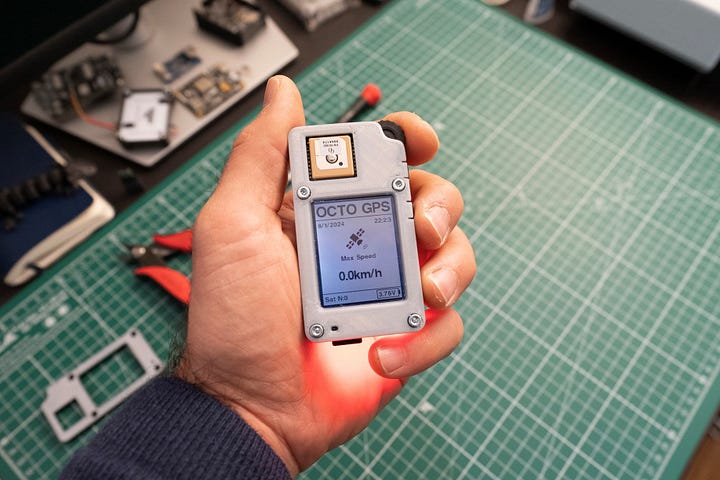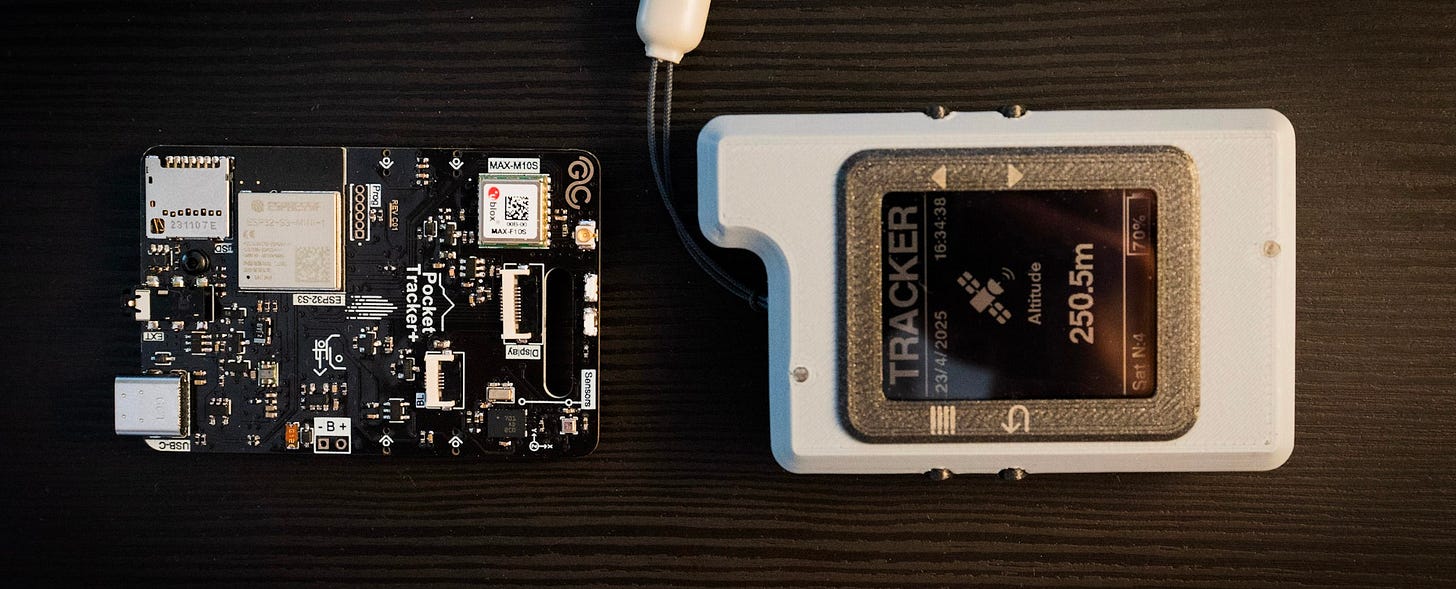Hey! I’m Gabriele, a freelance embedded developer from Italy. This is the very first issue of the Pocket Tracker Insider newsletter, and I’m really excited to open this new channel with all of you who’ve been following the project. My goal with this newsletter is to share updates about Pocket Tracker—news, hardware changes, production plans, and behind-the-scenes decisions—but also dive into some technical stuff now and then, because I know many of you enjoy that part just as much as I do. Thanks for being here. Let’s get into it!
Today’s Topics:
🖋️ A Bit of Pocket Tracker History
🔧 Design Update
📦 Production and Plans
🧩 Build your Pocket Tracker
🚀 What’s Next
A Bit of Pocket Tracker History
I’ve always been passionate about the outdoors, engineering, and science—and about a year and a half ago, I decided to build my own GPS tracker. I wanted a small device that could log my hikes or mountaineering trips as standard GPX files, but also let me explore the world through sensors—recording data, spotting trends, geo-tagging events, and even connecting external devices.
At the time, I had no professional experience working with positioning modules, so I dove in headfirst—reading, testing, and prototyping. My first GPS tracker was built using a custom development board I designed, along with a few expansion boards. It worked! And I loved coding for it so much that I decided to take it further.


The second prototype was my first fully custom PCB—no evaluation boards—and that felt amazing to hold. I added more sensors, a bigger display, better layout... but it still wasn’t enough. I wanted longer battery life, better portability, and easier expandability. That’s when Pocket Tracker was born.
Even the 3D-printed case evolved over time. If you scroll through my Instagram reels, you’ll see how many changes it went through—new button shapes, small design tweaks—often done in spare moments, even when I couldn’t work on the electronics. And while using it outdoors, I was constantly improving it.
Now I finally have a solid design: a reliable PCB, a tested and rugged 3D-printed case, and power-efficient firmware that lets me track for up to 48 hours straight. In my regular use, I only charge it every 2–3 weeks.
The community on Instagram has been a huge part of this journey—some features were actually born from DMs or post comments. That interest gave me the push to share Pocket Tracker with others who want to build their own. That’s why I started this newsletter and why I’m preparing a small first batch of PCBs. If you’re reading this, it means you're part of this little adventure—and I’m really grateful you’re here. This is just the beginning.
👉 Want more details? Visit the Pocket Tracker page on my website: Pocket Tracker Page
Design Update: A Better Sensor and a Smarter Layout
The final version for the first production batch is here! I’ve manually assembled a couple of prototypes to test everything, and things are looking solid. There are two main changes worth talking about.
1. EXT Connector Moved
I’ve repositioned the EXT connector to the bottom of the device, next to the USB-C port. It used to be on the side, but this new placement makes everything much easier to handle—especially when you’re plugging in cables or mounting the device. It also helps make the whole package more compact and clean.
2. BME680 → BMP390
Originally, I included the BME680 as an all-in-one environmental sensor. It’s a powerful chip with temperature, humidity, pressure, and gas sensing, but in real-world use, it just didn’t make sense. Inside a closed enclosure, with components running, the temperature readings were always a few degrees too high—and when carrying it in my pocket, the readings became completely inaccurate. Since relative humidity depends on correct temperature for compensation, the RH data became unreliable too. So I was left with a pretty expensive sensor that couldn’t work properly in this setup.
Instead, I decided to simplify: I removed the humidity and gas sensing and went for something much more reliable—just temperature and pressure. The BMP390 is one of Bosch’s best pressure sensors, and pressure is essential for accurate altitude tracking. I’ve tested it, and it’s working great.
Production and Plans
The first small batch of PCBs is about to launch! By the time you read this, there’s a good chance the factory will already be printing REV C01. In just a few weeks, Pocket Tracker will finally be available—and here’s how it’s going to work.
I’ll be using the Elecrow Store to distribute the PCBs worldwide. You’ll be able to choose between two options:
PCB only
PCB + LCD display (No back light version)
I know you're curious about pricing, so here's my current estimate:
~130$ without the display, and ~150$ with the display.
Yes, I know that’s not cheap—but it's the result of a lot of work and testing, and every component has been carefully selected. This first batch is small, and margins are minimal—but at this stage, what matters most to me is delivering something solid. You’ll get:
A premium-quality, gold-plated PCB
Original components
A design I’ve iterated on and tested extensively
I chose Elecrow not only for manufacturing, but also because they make international distribution way easier for a one-person project like mine.
Building Your Pocket Tracker
So, what if you buy just the PCB? There are two ways to complete the build:
1. DIY Build
All 3D files will be released for free, so you can print the case yourself. If you choose the display version, you’ll only need to source a battery and an antenna—both are standard parts and I’ll provide sourcing info to make things easy.
2. Special Edition Case (from me)
For those of you who want something a bit more special—or just want to support the project even more—I’ll also offer a complete case kit.
This will include:
The 3D-printed case
Laser-engraved custom graphics on the back
A polycarbonate screen protector, already mounted
An antenna, matched to the design
I’m still refining the details and price, but I hope this option will appeal to those of you who like the idea of a limited edition, ready-to-go build.
What’s Next
Right now, I’m focused on three main goals to bring Pocket Tracker to life in the best way possible:
1. Smooth Production
The first batch is small, but I want to make sure everything goes smoothly—no surprises, no missing components, no last-minute fixes. I’m working closely with the fab and double-checking every detail before giving the final green light.
2. Solid Firmware Out of the Box
Even though Pocket Tracker is meant to be hackable and mod-friendly, I want to ship it with a reliable, complete firmware that’s useful right away. Whether you're a developer or not, you should be able to power it up and start logging, tracking, or exploring its features with no extra setup. Of course, you can always flash your own firmware and customize everything, but my goal is to give you a solid starting point.
3. Expandability with External Modules
The EXT port on the device can be configured as I2C, serial, GPIO, interrupt—it’s super flexible. I plan to design a few expansion modules to add even more capabilities. First on the list: bringing back environmental sensing in a smarter way, as an external module. That way, I can solve the issues I had with the internal BME680 and offer accurate data again.
But honestly, I have many more ideas—and I’d love to hear yours too. What kind of modules or add-ons would you find useful?
Feedback
Thanks for reading this first issue of Pocket Tracker Insider! I’m really happy to finally start sharing all this with you in a more organized way. I’ll keep you updated as I test the final prototypes and get closer to launching the first batch.
If you have questions, ideas, or just want to say hi, feel free to reply—I’d love to hear from you.
Until next time 👋






Hi :)
It is a great project, and I can imagine that's a really big job behind it!
And the price estimation feels absolutely fair.
By the way, why with LCD but without a backlight? Can customers have some recommendations on a proper backlight creation by themselves?
Good job! And excellent project!